For people struggling with weight loss and obesity, getting fit can often seem like an uphill, next to impossible task. We understand the reasons why this might be and would like to offer you a comprehensive solution that is sure to produce impressive results if you follow it consistently even for one month only. This is a complete fitness plan that has been designed by our experts here at Trainer.ae, with a lot of information and tips that will work for anyone who is trying to lose weight and is having a hard time of it.
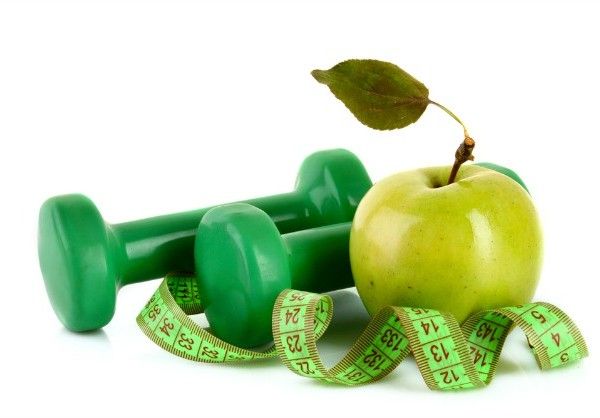
This guide will cover very important fitness issues such as how your genetics might be responsible for your weight and what you can do to beat it, what foods to eat, the type of exercises that might be more appropriate for you and etc. Ready to find out how you can finally get into the shape you have dreamed of all your life? Read on.
- Genetics and Body Type
There are three main body types that are distinctly identifiable by their size and shape. These are Ectomorph, Mesomorph and Endomorph. Perhaps you have got this really skinny friend who seems to eat so much more than you do but never seems to gain any weight at all; this person is probably an ectomorph.
- Ectomorphs as characterised by their skinny frame, very fast metabolism and difficulty in building muscles or gaining weight at all. Their fast metabolism rate is one major reason why ectomorphs struggle to gain weight but we’ll elaborate on that in the next point. Ectomorphs usually don’t have to worry much about weight loss, so we’ll not focus so much on this group.
- Mesomorphs have what is probably the most desirable body shape particularly as they have moderately large bones, a high carbohydrate tolerance, fast metabolism and muscular build. If you have a Mesomorph’s shape then you might gain a bit of weight fairly easily but you also won’t struggle to lose weight very much, as your body aids in the process naturally.
- Endomorphs, with a slow metabolism rate, larger bones and usually wider frames, are the body type with the highest propensity to gain weight regardless of how much they eat, and the majority of obese people have an endomorphic body type.
Metabolism Rates

We have said a lot about metabolism rates and how it affects the weight of individuals and its correlation with individual body types. The word metabolism is bandied about quite freely in a lot of fitness articles but most people still don’t understand what exactly it is. Understanding metabolism and how it works is important because you can actually influence your metabolism, which in turn affects your weight loss/gains. So what exactly is metabolism and how does it affect your weight?
Metabolism is the process through which your body converts resources such as food into energy. Actually, that’s just one part of the process–called catabolism. The other part of the metabolism process is called anabolism and this is the process through which the body uses the energy produced in catabolism to build tissues and carry out other functions. Food is the primary resource that is converted into energy but if you don’t eat enough, your body may convert your muscles and fat into glucose which is one reason we think crash diets might be effective in principle but are inefficient and fundamentally unhealthy.
The process of metabolism more or less begins when you eat. Food contains chemical energy which is measured in calories and when you eat, two things happen to those calories: they are either converted into energy for your body’s regular functions or they are stored as fat. Metabolism is kind of like driving a car: the faster you drive, the more gas you burn over the same distance.
Some people—ectomorphs–naturally have metabolism rates that drive fast all the time, such that their bodies extract the calories in food rapidly and burn off relatively massive amounts of calories in the process, such that that there is very little left over to be stored as fat. In people with an endomorphic body type, however, metabolism is usually much slower and as a result, less calories are burned with a lot more excess calories to be stored as fat. If you have ever wondered how on earth your skinny friend manages to eat more than you, here’s a theory (unproven) which might explain it: the faster you drive, the more fuel you use, and the more gas you will need to buy. Does this mean you should eat less food, if you have an endomorph body type? The answer is yes and no. No, you don’t necessarily have to eat less food but yes you should eat less high-calorie foods.
So the really interesting and perhaps, you might say, unfair thing is, a person struggling with their weight might eat the exact same meal as another person would and gain more weight because their body extracts the same amount of calories but uses up less calories in the process! You might consider this to be a disadvantage, but it’s not a disability; there some simple tools you can use to speed up your metabolism such as diet and exercise.
Diet

As said previously, a good diet is one very good way people can speed up their metabolism and influence their weight gains and losses. Certain foods take longer to digest and therefore slow down the process of metabolism. You should avoid these as much as you possibly can, and instead actively go for foods that are digested very easily and thereby speed up your body’s metabolism rate. Some examples of foods that are good and bad for metabolism rates are shown below:
Good
Generally, fruits, fibers and fats are good for increasing your body’s metabolism.
Avocadoes
Yoghurt
Sweet potatoes
Bad
Fried Foods
Carbonated drinks
Caffeinated drinks
Aside from eating to speed up your metabolism, diet has a major role to play in helping you lose weight. You should obviously avoid overstocking on carbs, which are usually quite high in calories, but it really isn’t just as simple as that. The proportions in which you should eat these foods will actually vary based on your body type.
Endomorphs need to eat less carbs, more protein;
Mesomorphs do well on a evenly split balance between protein and carbohydrates;
Ectomorphs need to eat a lot more carbs—approximately double the serving of protein.
Some amount of fats and oils should also be consumed in moderate amounts for all body types.
For some idea of specific foods that will supply you with proteins, fats and carbs, check out the table below:
Common Foods
| Carbohydrates | Proteins | Fats and Oils (polysaturated and monosaturated) |
| Bread | Lean Meat (Beef, Chicken, Fish) | Nuts (peanuts, almonds etc) |
| Rice | Dairy (Cottage cheese, Greek Yoghurt) | Fish |
| Potatoes | Kidney Beans | Cheese |
| Spaghetti | Soy | Avocado |
Exercise

Exercise simply has to be a major component of any weight loss plan because it is one of the fastest ways to burn calories. But you can’t go out and do just any exercise, you have got to understand the benefits each exercise may yield and choose the exercise that matches the fitness requirements of your body. Running, for instance, is often the first exercise people think of doing when trying to get into shape. It is a great cardio activity, but for endomorphs who have a lot of weight bearing on their knees, injury is also a very real risk. Sprinting, however, as a part of a High-Intensity Interval Training routine, is a better idea.
We would recommend that Endomorphs pursue an exercise plan that involves a mix of different training techniques, focusing on cardio and resistance training combined. Cardiovascular exercise is a group of exercises which involve the sustained motion of major limbs in the body and results in increased: heart rate, breathe intake and calorie burns. Cardio exercises are very good for health generally and highly recommended for people trying to lose weight. Running is not the only good cardiovascular exercise and a great alternative, for endomorphs and everyone else, is swimming.
Swim for weight loss
You can burn, on average, 500 hundred calories in a single hour of swimming which is more than you would, running. Additionally, the effect of running on the knees and other joints is greatly mitigated as water bears the weight of the body when swimming. Swimming is also great for toning muscles, which is one of the key goals you should be aiming for when you’re trying to get fit. You should probably swim for at least an hour, three to four times weekly.

High-Intensity Interval Training (HIIT)
This is a workout technique that has gained popularity, in the sports world, in recent times. In HIIT, you perform an anaerobic exercise such as sprinting, at a very high intensity, repeatedly, with short recovery periods in between. Just ten minutes of HIIT could have way more health and weight loss benefits for you than most other forms of exercise including aerobics. When combined with other cardio exercises and resistance training, HIIT can be the secret weapon you need to help you defeat excess weight.
The most common HIIT technique in sports are suicide runs. These are simple (but not easy) to perform and you may do them in your own backyard if you have enough space.To complete a set of suicide runs, all you have to do is sprint to and fro a short distance, say 10-15 feet, then repeat for increasingly longer distances without rest.
Strength Training (Resistance training)
Stronger muscles will aid in the weight loss process, as increased muscle mass will lead to an increase in metabolism rates and of course, more fat will get burned. Don’t rush out and start pumping iron just yet though, as for endomorphs, pumping iron will probably lead to a rapid mass increase which might not exactly be what you’re after, unless you’re a wanna-be power lifter or something of that sort. We recommend that you start your resistance training with bodyweight exercises.

Firstly, resistance training is a group of exercise which forces muscles to exert themselves against the resistance of external forces. This causes the muscles to work harder, sustain tiny tears (major tears would be injuries), and grow by adding a little extra muscle when the body repairs those tears. Bodyweight exercises are a sub-group of resistance exercises which force your muscles to exert force against the resistance of your own body. For example, squats, push-ups and most other exercises which can be performed without the use of any equipment are bodyweight exercises.
The bodyweight exercises we will recommend, will help to develop all the major muscle groups in the body including the upper body muscles (arms, chest, shoulders and upper back), core muscles (abdominals and lower back) and lower body muscles (butt, hamstrings, quadriceps and calves).
To target the upper body muscles, we recommend that you do push-ups. For a beginner, 3 sets of 10-15 push-ups will provide a relatively intense workout. You should look to increase the number of push ups you do in each set, by 10% each week.
For the core, there are a ton of exercises you can do but we’re going to recommend that you do planks. Planks are a type of exercise called isometric exercises, which involve putting a particular muscle group in a stress position for a sustained period of time. Isometric exercises will not be effective for increasing muscle size, past a certain point, but they are very effective at increasing the strength of already existing muscles which is great for muscles such as the abdominals, which are already fairly developed naturally.
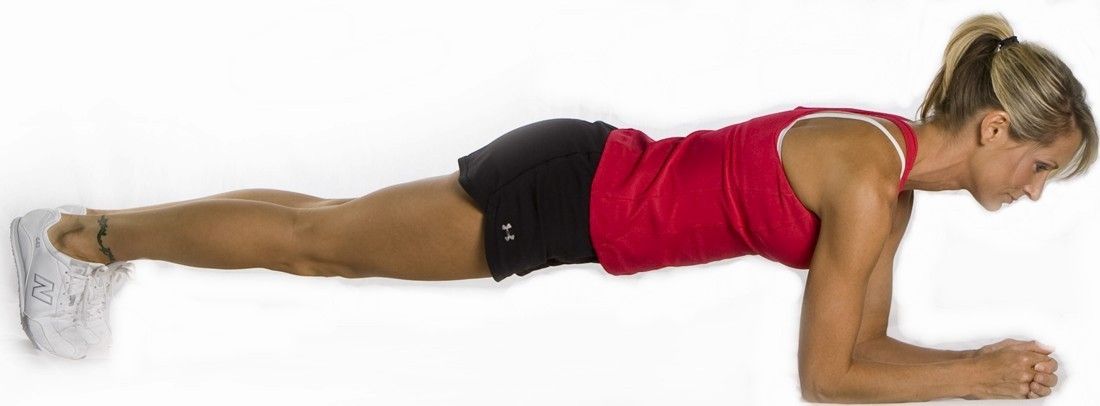
There are a lot of sites and writers out on the web, and elsewhere, who would be happy to tell you that doing sit ups and crunches are a waste of time for developing strong abdominal muscles but then we’d be sorely tempted to ask why, then, professional sportsmen do these exercises? The truth is that the body already has fairly developed abdominal muscles which are used in a number of different situations on a daily basis even in obese people. These muscles may, however, be covered by layers of fat, so if what you’re gunning for is having more visible abs, then fat loss is the way to go and you may not need to do much abdominal work. But we’re not advocating for mere aesthetics here: true strength gains in your abdominal muscles can only be had by doing the appropriate strength training, and for this you could go with good ol’ faithful sit-ups or crunches. Our favourite exercise for abdominal muscles, though, is the plank.
How to do the plank- You perform the plank by taking up the push-up position with your arms fully extended and your body fully straightened out. Hold this position for 1 minute or 1 ½ minutes and repeat 3 times. To make it easier, you could bed your arms at a 90-degree angle and use your elbows and forearms to provide support instead of your outstretched arms.
The reason the plank is our favourite abdominal exercise is because it is an isometric exercise and it targets multiple muscle groups at the same time. Although the primary muscles targeted (if you use correct form), when you do planks, are those in the abdominal region, your shoulders, gluteus (butt) and quadriceps also receive a strong secondary workout.
For the lower body, we recommend that you do squats. There are three major types of squats that you need to know about: the front squat, the back squat and the isometric squat. The front and back squat are both dynamic in nature but are different from plyometric squats (jump squats). Plyometric exercises are the opposite of isometric exercises, and involve the stretching and contraction of muscles in rapid, repeated motion. You could think of isometrics as being strength developing and plyometrics as being power developing.

Both the front and back squat target the quadriceps, hamstrings, gluteus and lower back but with the front squat, the quadriceps are the targeted a bit more and with the back squats, the hamstrings and gluteus are targeted a bit more. With both techniques, the lower back and abdominal muscles receive a secondary workout.
With the isometric squat however, the distribution of muscles targeted is much more limited—only the targeted muscle is efficiently strengthened–and you only gain strength at a range of 15 degrees either side of the angle at which you perform the exercise. What this means, in practice, is that if you do isometric squats, your knee joint and muscles will experience some strength increase; however, you may not experience these benefits when you need to extend your knees significantly beyond the angle at which you trained.
You’re doing these exercises for weight loss, though, so all that jargon may not really be relevant to you. The increased joint and muscle strength you can gain for isometric squats will help make your body leaner and less fat-friendly. For beginners, any one of these squat techniques will help achieve the desired effect and we recommend that you do 3 sets of 15 front or back squats. Or 3 sets of 1 ½ minute-long isometric squats.
How to do squats
The front squat- place your clenched fists under your chin, then go down, pushing your butt out from under your body and maintaining your head upright as you go down until your elbows touch your knees. If you do this right, your butt show extend slightly below knee level. Then extend your body upwards, keeping your back upright and taking care not use jerky movements. There are other ways to perform the front squat, such as the one shown in the image above.
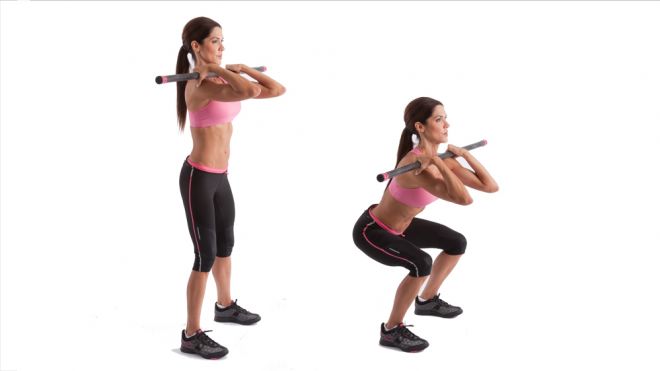
The back squat- hold a rod and hold it in place, balanced on the muscles on the back of your neck or on your shoulders. Go down until your butt is parallel with your knees, and come back up. Be careful not to pull down or exert pressure on the rod as you go through this motion.
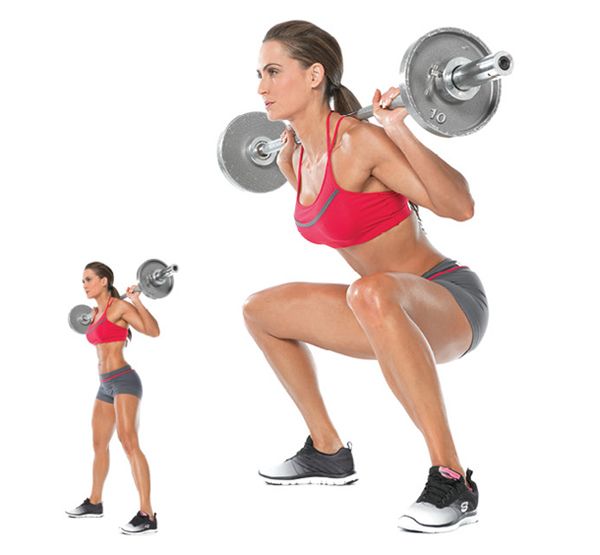
The isometric squat- this is just a stationary squat and you can perform it by holding the “hole” position when you go down on a front or back squat. The more conventional way of performing the isometric squat is to stand with your back against a wall and then go down until your knees form a 90 degree angle with the wall. You should stay in that position for at least 90 seconds.
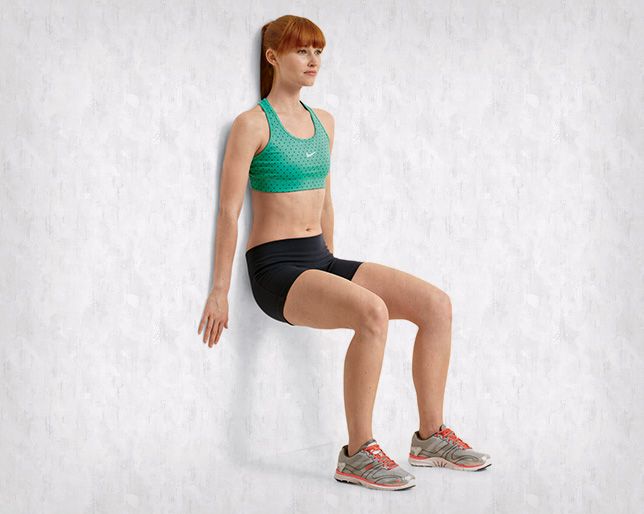
You could design your own workout plan to include cardio, and resistance training for these muscle groups or you could follow our simple exercise guide as below:
Mondays: Resistance Training–3 sets of 15 push-ups, 3 sets of planks @ 90 seconds per rep, 3 sets of 15 back squats
Tuesdays: Cardio one hour of swimming or cycling/HIIT
Wednesdays: Rest
Thursday: Resistance Training–3 sets of 15 push-ups, 3 sets of planks @ 90 seconds per rep, 3 sets of back squats
Friday: High intensity Interval training- running suicides/tennis/basketball
Saturday: rest
Sunday: rest
For a lot of people, going through a workout plan on their own can be quite hard. We think that having a fitness instructor might help you and if you would like the services of a professional fitness trainer, we would be glad to connect you with someone you can trust if you would contact us at:
If you would like the services of a personal trainer to help structure your training plan, please get in touch with us at:
Contact Trainer.ae: get in touch with a personal trainer who can help create a plan just for you.
______________________________________________________________
WhatsApp number: +971 56 58 30067 (please send code 2294 and we will get back to you asap)
______________________________________________________________
Sleep

Did you know sleep is an essential component of your weight loss plans? A lot of people do not know this and consequently do not pay any attention to just how much sleep they receive. Well, you simply can’t afford to put in all that hard work, and yet have your weight loss plan ruined by something so seemingly innocuous as too little sleep. Here are the reasons why sleep is so important for you:
- It has been found that people who sleep too little have a tendency to overeat throughout the day. If you’re an ectomorph this shouldn’t bother you very much but for endomorphs it ought to send the alarm bells ringing in overdrive.
- Too little sleep is also proven to negatively influence glucose tolerance and insulin sensitivity. The effect of this is that your body will not deal with glucose in the normal way that it should and will instead store more of it as fat, than it ought to.
- Your body needs sufficient sleep to repair your muscles in the post-workout recovery period. The real work of building muscles happens when your body begins to rebuild the damaged tissues, so if you prevent this process from being completed in its natural course, the effect would be to significantly limit the amount of gains you make, and weaken your body ahead of your next workout session.
So how much sleep is too little and how much is just right? This is an important point as too much sleep will also be very bad for your health and weight loss efforts. The consensus among scientists seems to be that 7-8 hours of sleep is the optimum amount.
Supplements

Sometimes, the body needs a little extra help to build muscle and get in shape, particularly for people who have the ectomorph body type. Nutritional supplements could aid your diet and workout plan and help speed up the process of getting fit. Of note, is the supplement Creatine which has been labelled a wonder drug by some. In reality, Creatine is not a drug so if the term makes you squeamish, there’s no need to worry.
Creatine is naturally found in muscles and is a core component of the body’s natural muscle building process. It also helps to energize and strengthen muscles, during performance, which obviously would help to increase the amount of work you can do and, in turn, the amount of gains to be made.
Conclusion
So, there you have it folks. The tips described here are guaranteed to yield impressive results in a matter of weeks. Watch out for the second part, which will focus on helping ectomorphs and other people gain weight.
Contact Trainer.ae
______________________________________________________________
Whatsapp number: +971 56 58 30067 (pls mention code 2294)
Contact us : Click here to send us your details we will get back to you asap.
______________________________________________________________
We do all the relevant checks for you. All trainers from trainer.ae have the right visa and are fully qualified to train you.
Get in touch with us today, Group fitness classes and one on one personal training available in Dubai, Abu Dhabi, Sharja, Ajman, Al Ain or RAK. Your health is more important than you know.